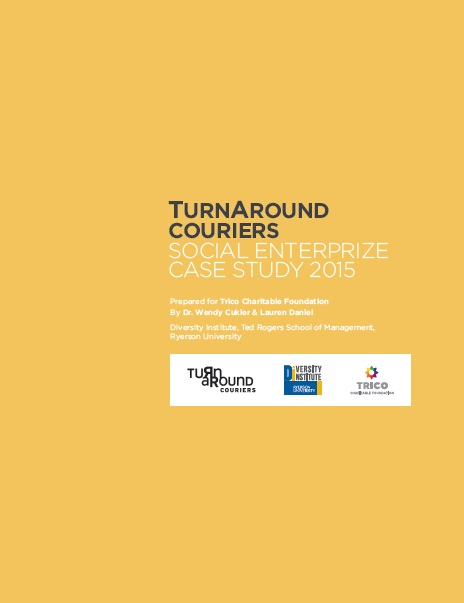This article was originally published on October 30th, 2015 on the Social Finance website. It has been cross-posted with permission from the author Ellen Martin, COO, SoJo.

SocialFinance.ca is thrilled to partner with Trico Charitable Foundation to provide a deep dive into the 2013 Social EnterPrize award recipients from the perspective of social entrepreneurs or individuals working in the social entrepreneurship environment. The Social EnterPrize awards seek to celebrate the best and the brightest social entrepreneurs in the Canadian context. This year’s awards will be announced and presented at the 2015 Social Finance Forum. TurnAround Couriers is one of the four 2013 Social Enterprize award recipients. This posts provides a deep dive into the case study. Stay tuned for the rest of the case studies over the coming weeks. Please refer to introduction blog post for more details.
My work at SoJo focuses on supporting young people in developing the skills, knowledge and competencies to use business to improve the world. In reading the case studies produced by Trico and its partners for the SocialEnterprize Awards, I was struck by how many valuable lessons were captured and believe that all aspiring social entrepreneurs – and social entrepreneurs who have not yet reached scale – should take the time to access this resource.
With this lens, I am pleased to have the opportunity to share a few of my key takeaways from the case study on TurnAround Couriers – produced by the Ryerson Diversity Institute and Trico Charitable Foundation.
TurnAround Couriers (TAC) is a same-day courier service with operations in Toronto. TAC was founded in 2002 by Richard Derham only two-years after he immigrated to Canada from Britain. TAC was born out of Derham’s desire to demonstrate that a for-profit enterprise could be both financially sustainable and achieve positive social impact through the practice of social hiring. For TAC, social hiring means hiring only those individuals from the target population – job-ready, at-risk youth between the ages of 18 to 29. As the only for-profit social enterprise in the group of SocialEnterprize award recipients, TurnAround Couriers is an excellent example of the potential for standalone for-profit business models to achieve financial sustainability and positive social impact.
Here are some my key takeaways;
A social purpose isn’t enough
This case study did an excellent job of highlighting an important issue for all aspiring social entrepreneurs to think long and hard about. While we as social entrepreneurs are often drawn to starting our business because of the social purpose of our work, Derham points out that our customers likely will not care nearly as much as we might expect. In fact, to grow a thriving business, “ the organization must present itself first and foremost as a competitive product offering before it can highlight the fact that it is also socially responsible”. This is a challenging – but important – proposition for social entrepreneurs who care deeply about the impact they are having.
Partnerships matter
Developing healthy partnerships has been key to the success of TurnAround Couriers. Their partnership with youth agencies and shelters (e.g Yonge Street Mission) mitigates some risk and reduces organizational resources committed to the hiring process. By hiring individuals referred to TAC by these agencies, they are able to develop “strong relationships between TAC and at-risk youth agencies and ensures candidates brought in for interviews meet TAC’s social mandate, reducing administrative costs associated with outreach.” Another important role partnerships have played is in securing customers. By maintaining healthy partnerships with firms like PwC and RBC, TurnAround couriers is able to build credibility and attract other large clients.
Form follows function
A challenge I often observe aspiring social entrepreneurs struggle with is getting stuck on the “form” of their social enterprise before they really define the “function”. Deciding between a non-profit or a for-profit corporate form or selecting a business model seems to leapfrog the important task of defining the purpose and “function” of the venture.
Founder Richard Derham started TAC by defining the purpose of his new business. Derham explains, “it was interesting to me to try a new business model and to try and prove that if we have a very clear differentiating strategy in place, such as social hiring, that we could grow quicker as a for-profit than our competitor groups in the sector”. By focussing in on the social purpose of “hiring only those individuals from the target population – job-ready, at-risk youth between the ages of 18 to 29” this precluded Derham’s new venture from pursuing many types of businesses. He explains, the business “had to be something that the targeted population could do. The youth at risk I’ve been working with can bicycle courier while they might not be able to work in other ventures one might choose to start. So it is important to tailor the nature of your operation to the community you are trying to help”.
But don’t take my word for it – I encourage you to read through the full TurnAround Couriers case study and share your key takeaways with SocialFinance.ca at @socialfinance on Twitter.

